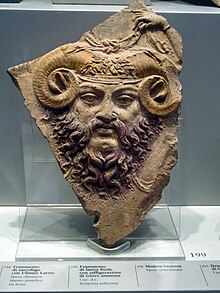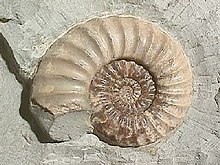Horns of Ammon

Thehorns of Ammonwere curling ram horns, used as a symbol of theEgyptiandeityAmmon(also spelled Amun or Amon). Because of the visual similarity, they were also associated with the fossils shells of ancient snails andcephalopods,the latter now known asammonitebecause of that historical connection.[1]
Classical iconography
[edit]

Ammon, eventuallyAmon-Ra,was a deity in theEgyptian pantheonwhose popularity grew over the years, until growing into a monotheistic religion in a way similar to the proposal that theJudeo-Christian-Islamicdeity evolved out of theAncient Semitic pantheon.[2]Egyptian pharaohs came to follow this religion for a while,AmenhotepandTutankhamuntaking their names from their deity. This trend caught on, with other Egyptian gods also sometimes being described as aspects of Amun.[3]
Ammon was often depicted with ram's horns, so that as this deity became a symbol of supremacy, kings and emperors came to be depicted with Horns of Ammon on the sides of their head in profile, as well as the deities not only of Egypt, but other areas, so that Jupiter was sometimes depicted as "Jupiter Ammon", replete with Horns of Ammon, after Rome conquered Egypt, as was the Greek supreme deityZeus.His deification as a conqueror had involved being declared the metaphorical "Son of Ammon" by the Oracle atSiwa.This tradition is thought by some to have continued for centuries, withAlexander the Greatbeing allegedly referred to in theQuranas “Dhu al-Qarnayn”(The Two-Horned One), a supposed reference tohis depiction on Middle Eastern coins and statuary as having horns,[4][5]consistent with the view of most scholars on Islamic exegesis that Dhu al-Qarnayn was Alexander the Great.[6][7]
Pliny the Elderwas among the earliest writers known to have associated spiral shells with the deity Ammon, referring to them asammonis cornua(horns of Ammon) in his bookNaturalis Historia.[8]Considering the relative rarity of ammonite fossils in Egypt, this may have originated with fossil snail shells likenatica hybridafound inMokattamlimestone nearCairo.[1]
The direct attribution of the Horns of Ammon with fossil cephalopod shells became common duringMedievaltimes with mentions by writers likeGeorgius AgricolaandConrad Gesner.These led to a widespread association that climaxed with paleontologistKarl Alfred von Zittelnaming the class of animalsAmmonoideain 1848.
References
[edit]- ^abThe Origin Of Geological Terms: Ammonites
- ^World History Encyclopedia: Yahweh
- ^The horns of Ammon;"The biblical narrative, however, is not as straightforward as it may seem as it also includes reference to the Canaanite god El whose name is directly referenced in 'Israel' (He Who Struggles with God or He Who Perseveres with God). El was the chief deity of the Canaanite pantheon and the god who, according to the Bible, gave Yahweh authority over the Israelites."
- ^Recent Ancient Coin Acquisitions Focus on Alexander the Great
- ^Ammonite to Ammolite
- ^Daneshgar, Majid (2020).Studying the Qur'ān in the Muslim Academy.AAR reflection and theory in the study of religion. New York (N.Y.): Oxford University Press. p. 77.ISBN978-0-19-006754-0.
- ^Griffith, Sidney (2022-03-15)."Narratives of" the Companions of the Cave, "Moses and His Servant, and Dhū 'l-Qarnayn in Sūrat al-Kahf".Journal of the International Qur'anic Studies Association.6(1): 146–147.doi:10.5913/jiqsa.6.2021.a005.ISSN2474-8420.S2CID251486595.
- ^NH37.40.167
